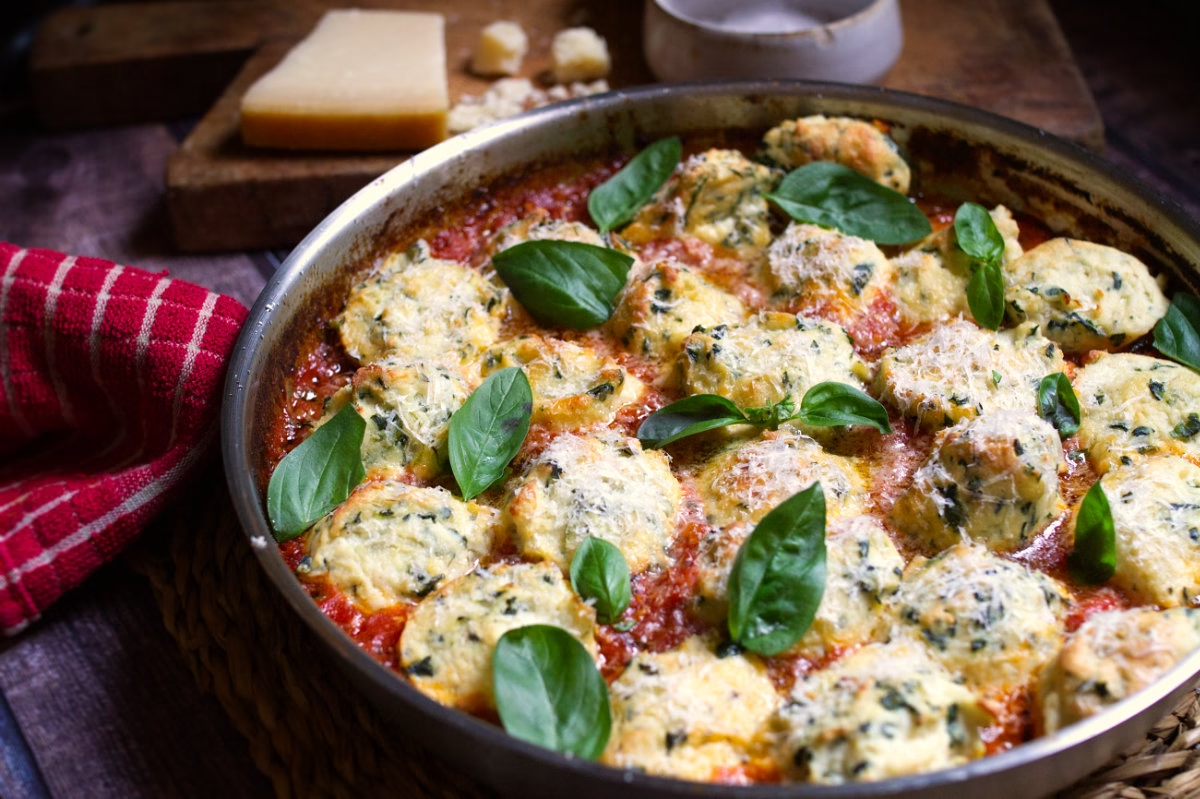‘Uglier the better’ is rarely something you hear in the Foodie world, but these Italian dumplings are exactly that. Malfatti (“badly made” in Italian — a tongue-in-cheek name for these ‘rustic’ dumplings) are delicate spinach-and-ricotta dumplings, similar to gnudi, and absolutely delicious when done right.
⚠️Now, a quick note on this recipe:
🍳First – ‘Done right’ really means ‘not easy’ and this recipe is a labor of love and not well suited to a weeknight meal. We suggest setting this recipe aside for a weekend, roll up your sleeves, open some wine, and take your time.
🍳Second – Prep work requires a fair amount of bench space and is likely to use most dishes and pots in your kitchen – or at least allow time for a few rounds of cleanup. We’d skip this recipe if you’re cooking in a small kitchen.
✅The good news is the end result is wonderfully delicious and somewhat ugly dumplings that are just lightly crisped on top and soaked up the Napoli sauce. All that effort is well worth it!
Italian | Main | Ricotta | Vegetarian | Parmesan
Table of contents:
- What you’ll need to make baked Malfatti in Napoli Sauce 🇮🇹
- Equipment
- Instructions
- Cooking Notes:
- Origin of Malfatti
- What are Malfatti Dumplings?
- Getting the texture right
- 🌿 1. Get the spinach really dry
- 🧀 2. Use high-quality, dry ricotta
- 🍞 3. Balance the texture — firm but not tough
- 🧂 4. Season generously
- 💧 5. Poach gently — don’t boil
- 🍅 6. Sauce wisely
- 🧊 7. Chill before cooking (optional but helpful)
- 🪄 Bonus: Bake instead of boiling
- Sauces used with Malfatti Dumplings
- Lombard Malfatti (Mantua/Brescia style)
- Tuscan Malfatti (Gnudi — “Naked Ravioli”)
- Napoli Sauce
- Wine pairings
- Quick Pairing Summary
- Nutrition Facts — Baked Malfatti in Napoli Sauce
- FAQs — Malfatti (Italian Spinach Ricotta Dumplings)
- 1. What does “Malfatti” mean?
- 2. What’s the difference between Malfatti and Gnudi?
- 3. Why do my Malfatti fall apart when boiling?
- 4. Can I make Malfatti ahead of time?
- 5. Can I use frozen spinach?
- 6. What kind of ricotta should I use?
- 7. Can I skip baking and just serve the poached dumplings?
- 8. What can I serve with Malfatti?
- 9. How long do leftovers last?
- 10. Are Malfatti healthy?
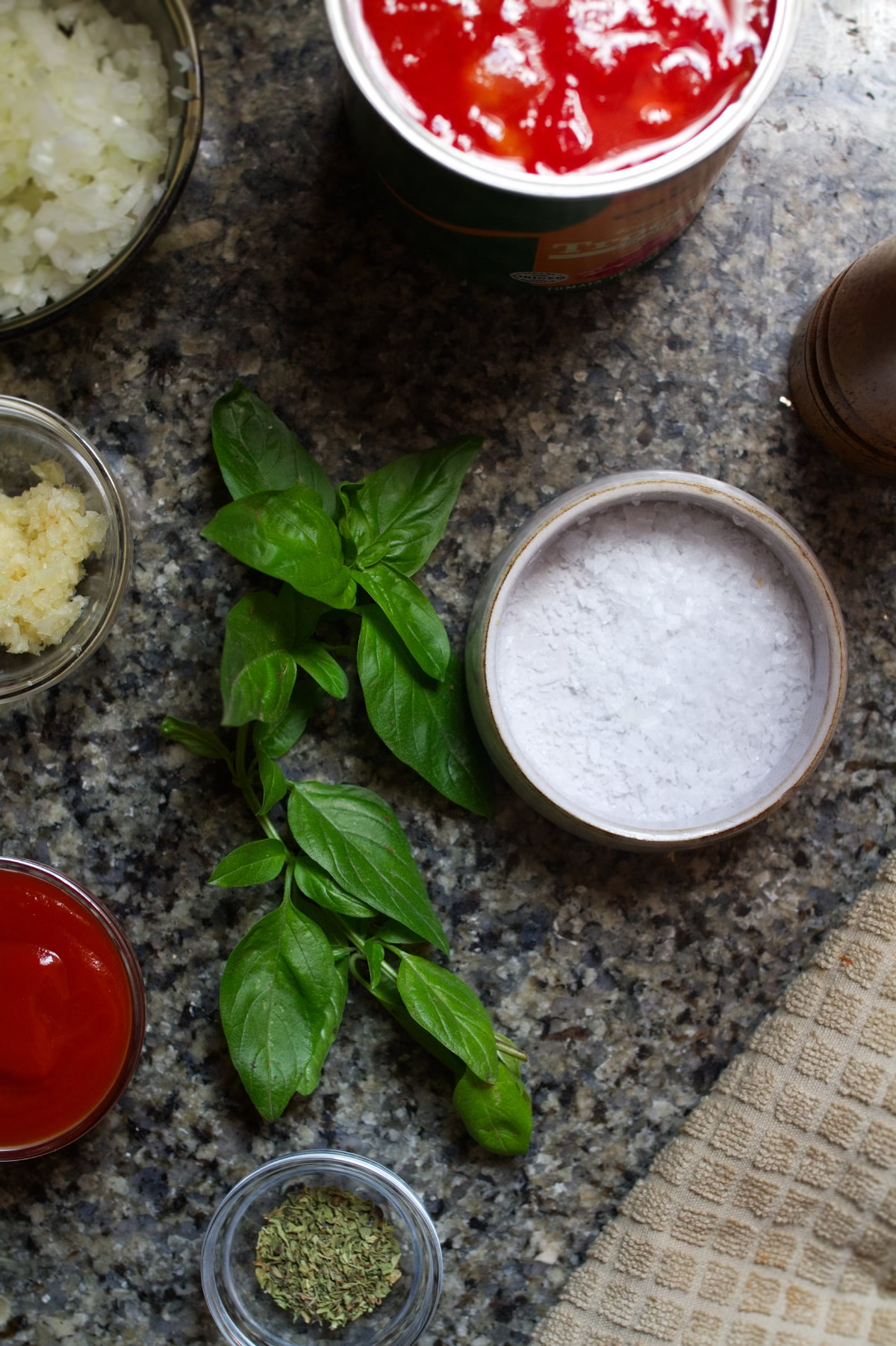
What you’ll need to make baked Malfatti in Napoli Sauce 🇮🇹
Ingredients
Napoli Sauce:
- Extra Virgin Olive Oil
- 1 small onion, finely diced
- 3 garlic cloves, minced
- 800 g (28 oz) canned Tomatoes (ideally San Marzano)
- 2 Tbsp Tomato paste
- ½ tsp Dried Oregano (organic)
- A few fresh basil leaves, with stems
- Salt and Freshly ground black pepper, to taste
- 1 tsp white sugar
Malfatti:
- 5 oz. (150g) spinach
- Salt
- 1 onion, diced fine
- 3 garlic cloves, minced
- 10.5 oz. (300g) Ricotta Cheese
- 50 g (½ cup) grated Parmigiano Reggiano DOP 18 months
- 2 Tbsp basil leaves, finely diced
- 2 egg yolks (discard the white)
- Pinch of grated nutmeg
- 1/2 cup all-purpose flour (add more or less to taste)
- Salt and Pepper to taste
For Garnish and Serving:
- Parmesan , finely grated
- Basil leaves
Equipment
- 12-Inch Stainless Steel Frying Pan or skillet
- Large Glass bowl
- Mesh Strainers (flour sieve)
- Baking/Cooling rack
- Parchment paper
- Wooden Cutting Board
- Chef Knife
- Garlic Press
- Immersion Blender (optional)
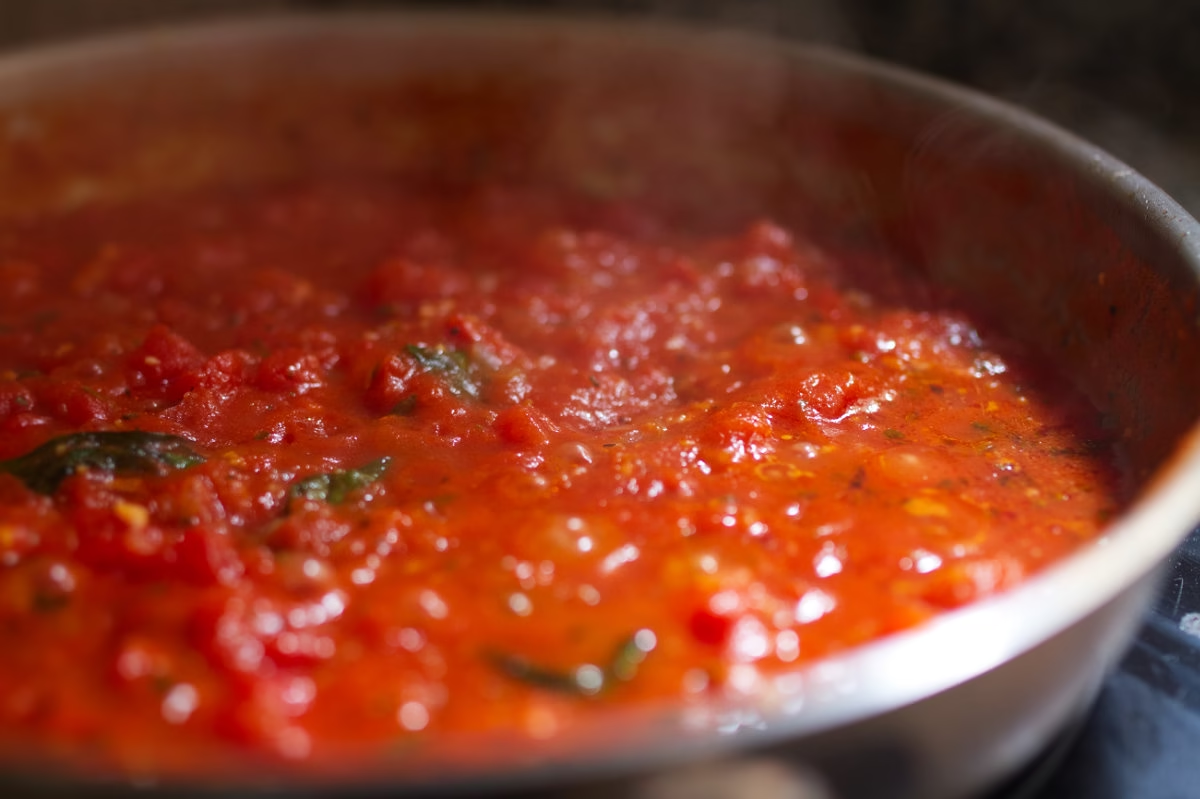
Instructions
Napoli Sauce:
Step 1 – Sauté aromatics
- In a wide pan, heat the olive oil over medium heat.
- Add the onion and sauté for 5 minutes
- Add the garlic and gently sauté until fragrant, around 2 minutes — do not let it burn.
Step 2 – Add tomatoes
- Add the canned tomatoes and stir through.
- If using whole (peeled) tomatoes, crush with a spoon or spatula.
Step 3 – Simmer
- Add a pinch of salt, some black pepper, and the tomato paste
- Reduce heat to low and let the sauce simmer gently for 20 minutes, stirring occasionally.
- The sauce should thicken slightly and the oil will rise to the top — a sign it’s ready.
- Taste and adjust seasoning (salt, pepper) and add any sugar if required.
- Add the bunch of basil and simmer for another 10-15 minutes.
- Remove the basil before serving or blending.
Optional:
- For a smoother texture, pass the sauce through a food mill or blend briefly with an immersion blender.
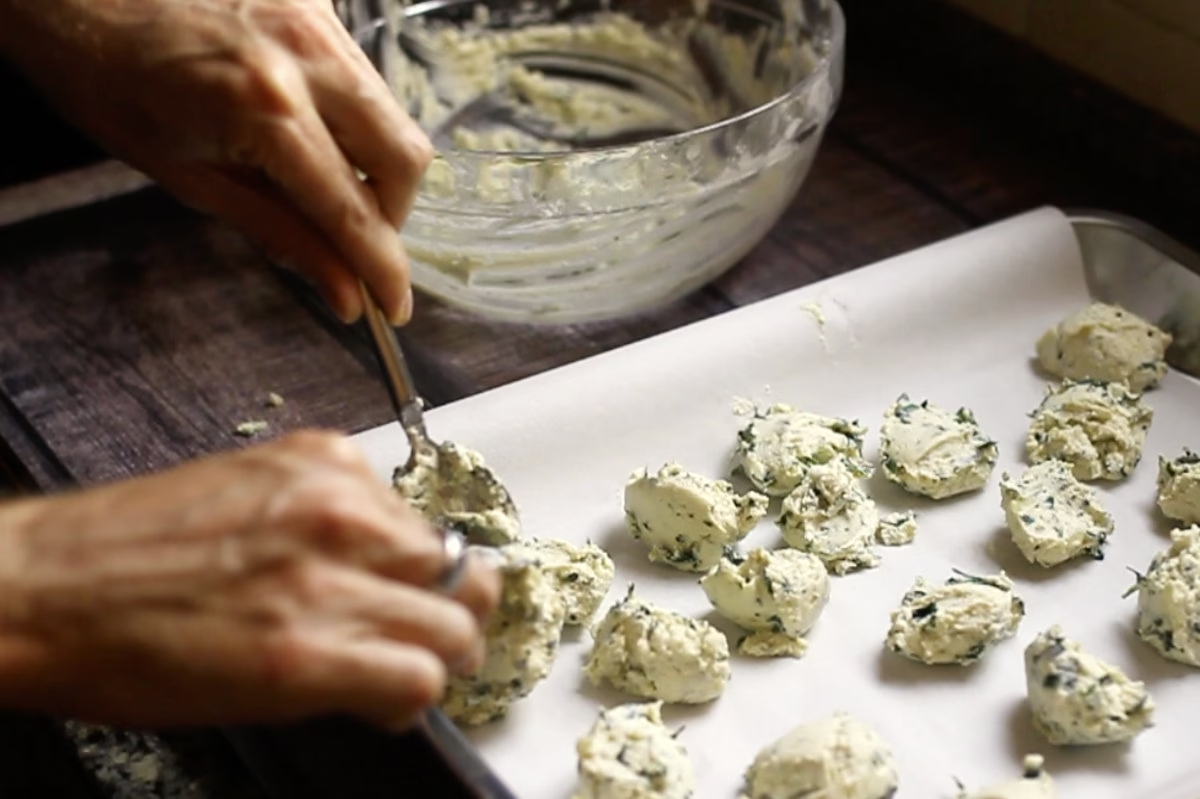
Prepare the Malfatti:
- Add spinach leaves to a drying rack and season generously with salt, leave for 20 minutes to draw out excess liquid.
- Use a kitchen towel to squeeze out excess liquid, then finely chop the spinach.
- Saute the onion for 5 minutes, then add the garlic and cook for another 1 minute, until fragrant.
- Add the chopped spinach and sauté for another 3-4 minutes to cook off some of the excess liquid.
- Remove sauteed spinach and onion from the pan and add to a large bowl to cool.
- Add the ricotta, grated Parmesan cheese, egg yolks, nutmeg, season with some salt and pepper to taste. Note: the spinach will already be quite salty.
- Add flour a few tbsp at a time and mix. Add more flour if the dough is looking too wet.
- Shape: Roll small dumplings (about walnut-sized) using floured hands. Place on a floured tray. Alternatively, use two spoons to shape your Malfatti balls.
- Refrigerate for 1 hour allow the balls to firm up and hold together better.
- Poach malfatti balls gently in simmering salted water until they float, then cook 1-2 minutes more.
- Remove balls from the water and set aside on some parchment paper to dry for 5 minutes.
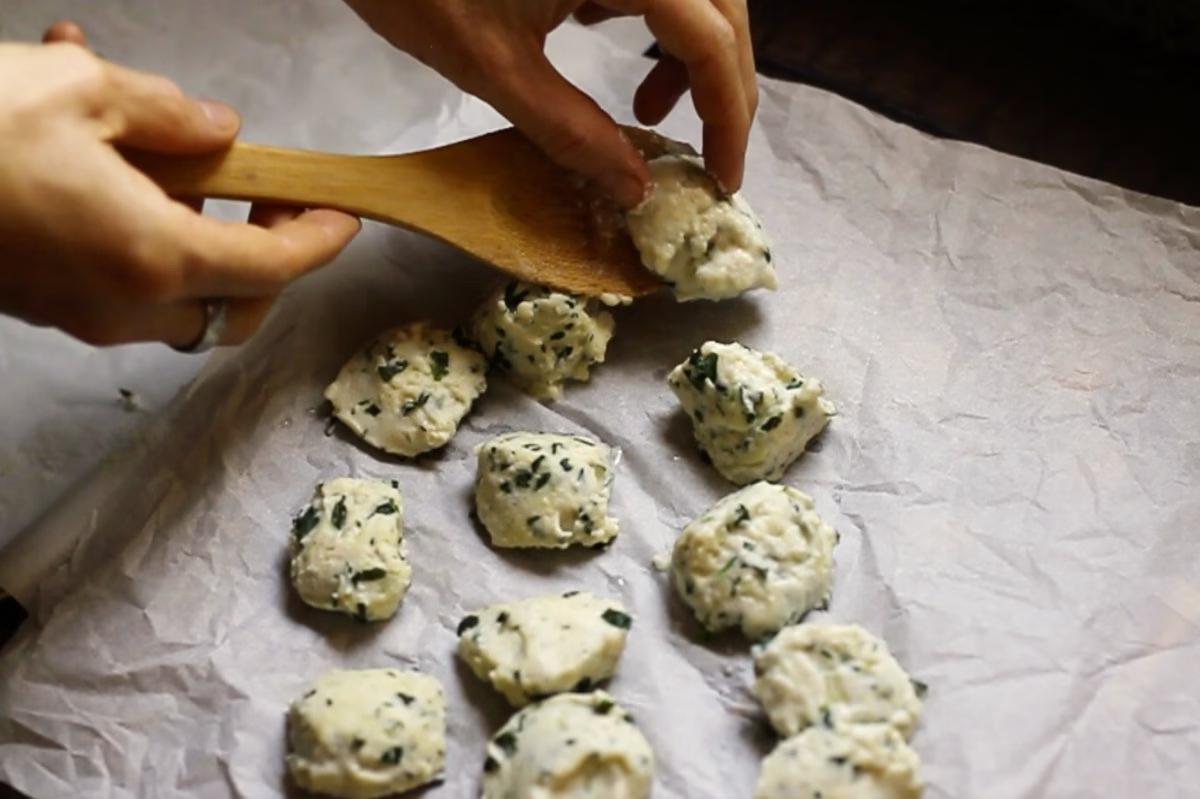
Baking the Malfatti:
- Preheat oven to 180°C / 350°F.
- Pour Napoli Sauce into a baking dish (or use the same pan as we did), then top with the Malfatti.
- Drizzle with extra virgin olive oil and lightly season to taste with salt and pepper.
- Bake for 20 minutes.
Garnish and Serve:
Garnish baked Malfatti with plenty of shaved parmesan cheese and a few fresh basil leaves.
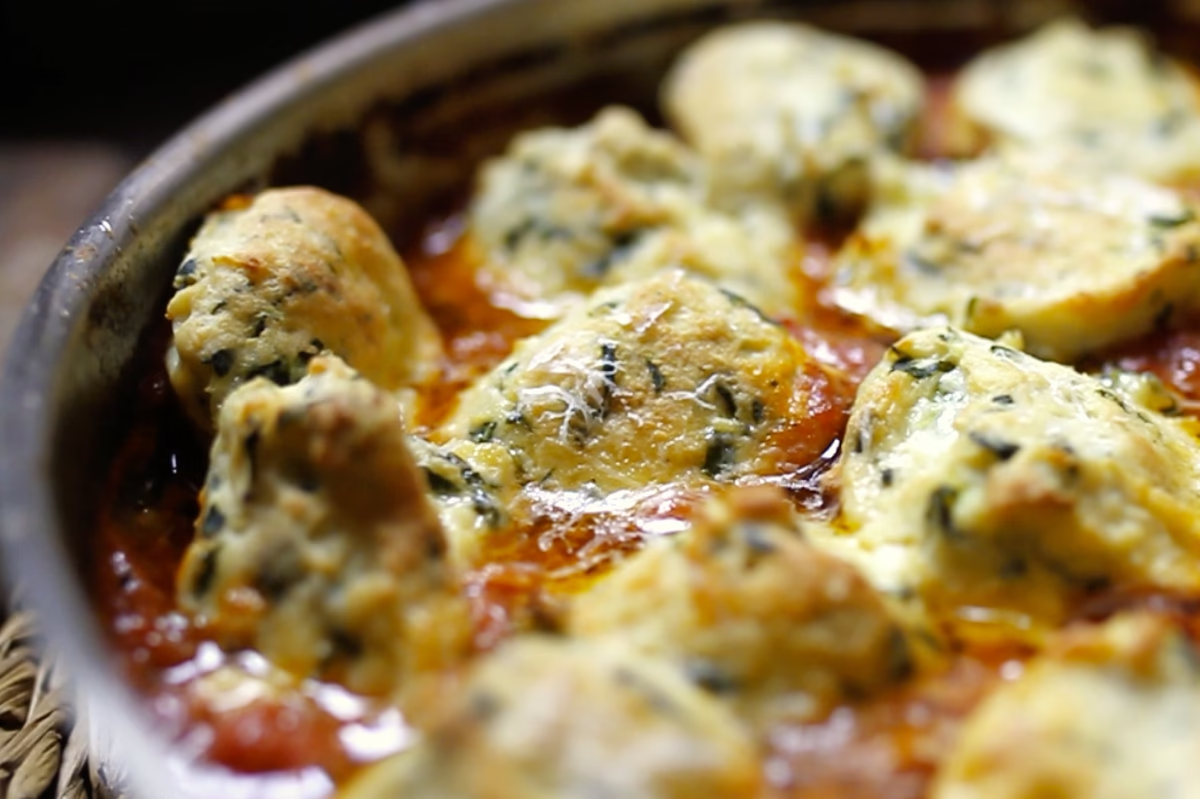
Cooking Notes:
Ricotta – Use the dry type that is usually found at the deli counter.
A few good brands:
- Casa del Formaggio
- Paesanella
Spinach – We prefer to use fresh spinach, however, frozen spinach can be used. If using frozen spinach, thaw it completely and then strain off all excess water. Use two plates to ‘press’ the spinach and release excess water.
Egg yolk – 2 yolks is great, one is not enough. You won’t need the egg white.
Cooking – Poach in simmering (not boiling) water that is lightly salted. Add dumplings in batches, and once they float to the surface, give them another minute or two, and then they are ready. Remove them from the water and put them on some baking paper to dry.
Bake for around 20-25 minutes – Remember that everything is already cooked and baking is just to get a nice crust on top.
Garnish- Once they cool slightly, sprinkle with shaved parmesan cheese and some fresh basil leaves chopped or whole).
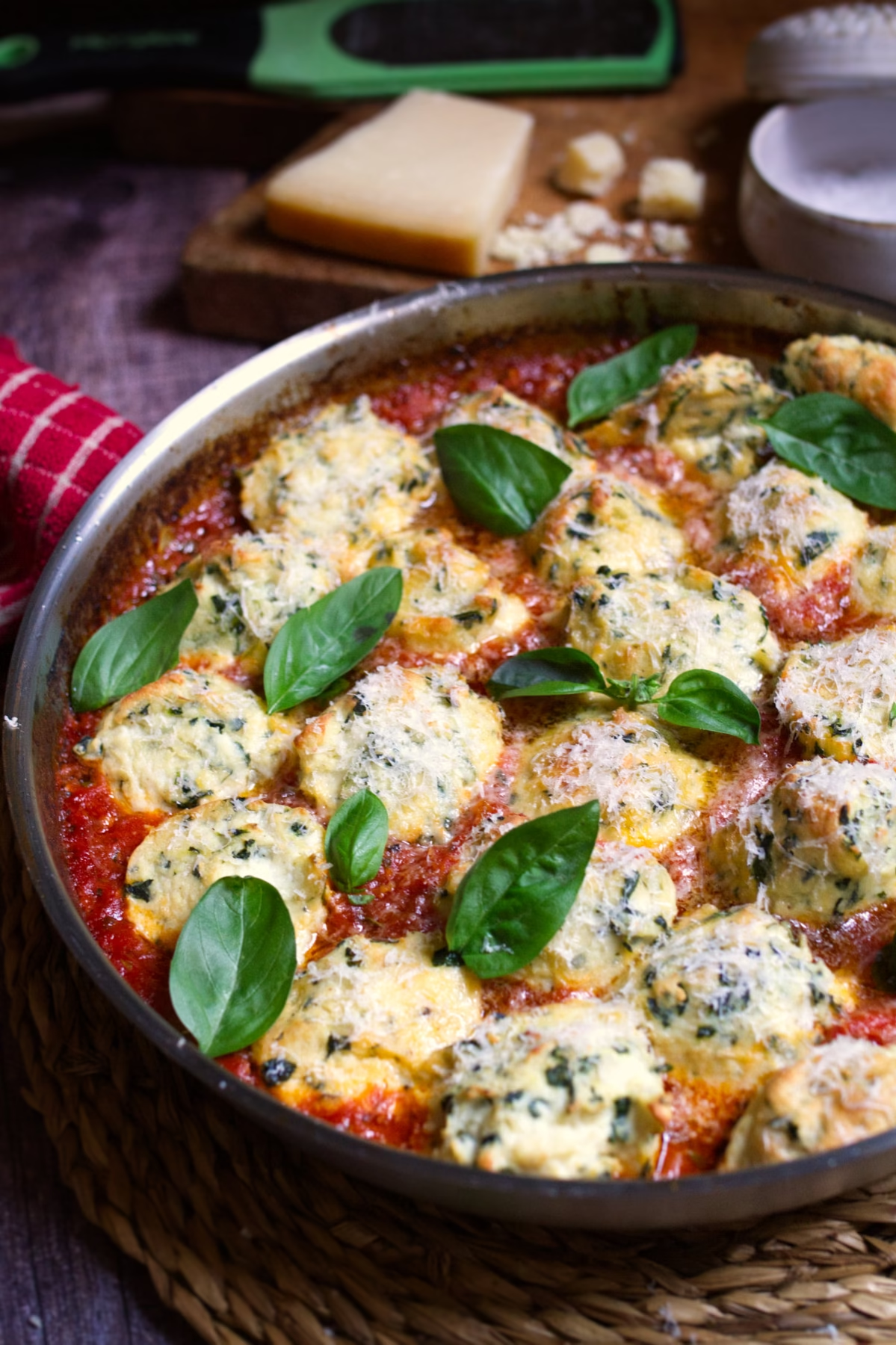
Origin of Malfatti
Malfatti have a humble and somewhat charming origin story rooted in northern Italy, especially Tuscany and Lombardy. Malfatti belong to the Italian tradition of cucina povera — “poor kitchen” or peasant cooking — where simple, inexpensive ingredients (greens, cheese, eggs, flour) were transformed into something comforting and special.
Of course, there are several renditions of stories of how the recipe came to be.
As one story goes- A farmer’s wife preparing ravioli accidentally ran out of pasta dough, so she simply cooked the filling as dumplings instead — and they turned out so delicious that the “mistake” became a beloved dish in its own right.
1. Tuscan Origins (Chianti & Siena region)
- The dish is believed to have originated in Tuscany, particularly in the Chianti and Siena areas, where it’s sometimes also called gnudi (“naked”).
- The idea was that these were the “naked” ravioli fillings — made of spinach, ricotta, Parmesan, and nutmeg — but without the pasta wrapper.
- The name Malfatti literally means “badly made” or “poorly formed,” poking fun at their rustic, imperfect shape.
2. Lombard Variations (Northern influence)
- In Lombardy, particularly around Mantua (Mantova) and Brescia, you’ll also find malfatti made with semolina or breadcrumbs instead of flour, sometimes mixed with chard or herbs.
These versions often have a slightly firmer texture and are served with butter and sage or a light meat ragù.
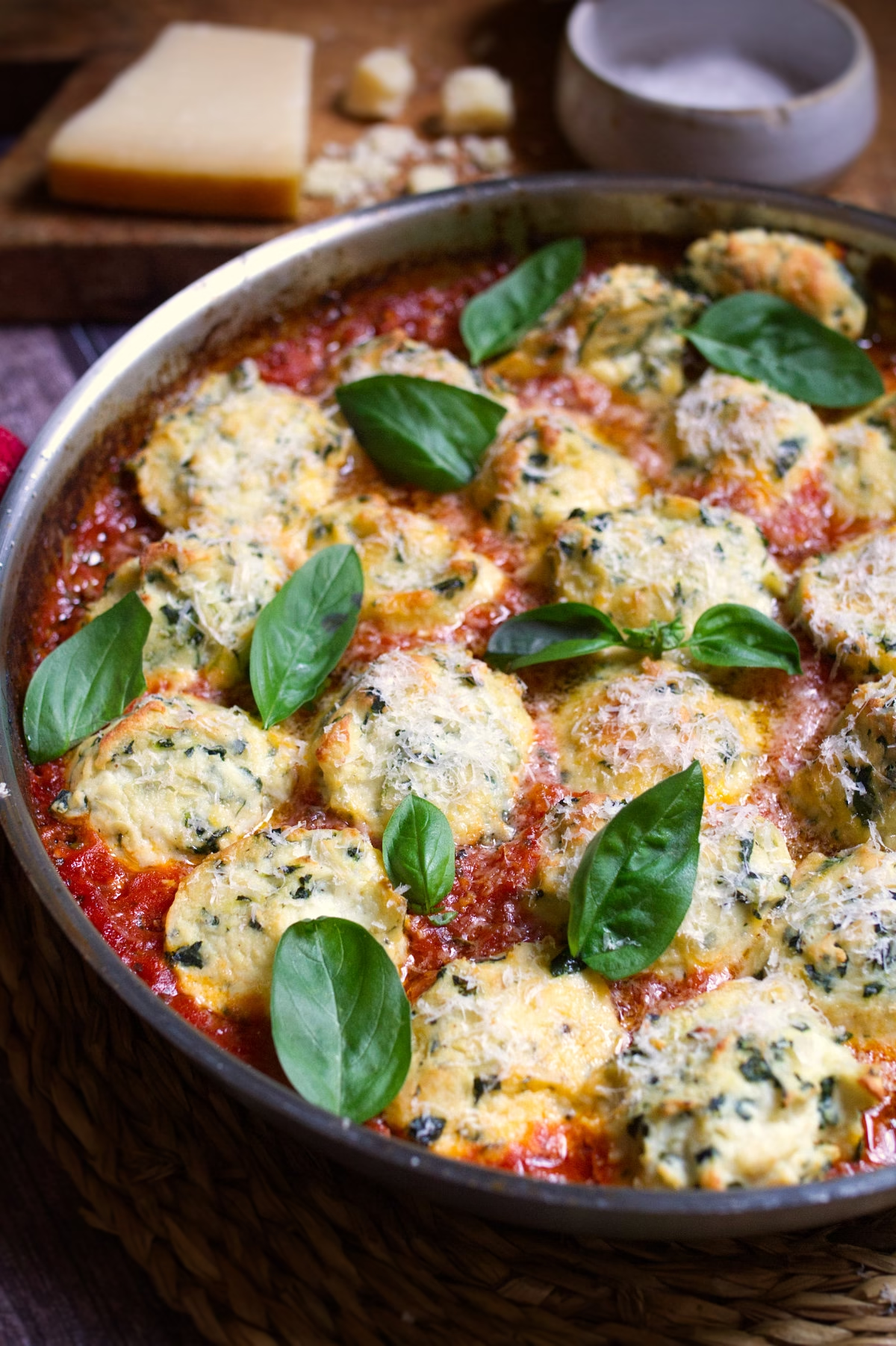
What are Malfatti Dumplings?
‘Uglier the better’ is rarely something you hear in the Foodie world, but these Italian dumplings are exactly that. Malfatti (“badly made” in Italian — a tongue-in-cheek name for these ‘rustic’ dumplings) are delicate spinach-and-ricotta dumplings, similar to gnudi, and absolutely delicious when done right.
The trick to making them is getting the texture of ingredients just right so they stay together when boiled in water (the right amount of flour is key here), and this is where it’s also important to use the palms of your hands to press firm (slightly wobbly looking) dumplings.
Getting the texture right
Looks aside, perfecting Malfatti is something of an artform, and you’ll want Malfatti that hold together, stay tender, and taste amazing. Fortunately, it’s not too difficult and we managed to do it on the first try making the recipe.
⚠️Now, a quick note on this recipe:
🍳First – ‘Done right’ really means ‘not easy’ and this recipe is a labor of love and not well suited to a weeknight meal. We suggest setting this recipe aside for a weekend, roll up your sleeves, open some wine, and take your time.
🍳Second – Prep work requires a fair amount of bench space and is likely to use most dishes and pots in your kitchen, or at least allow time for a few rounds of cleanup. We’d skip this recipe if you’re cooking in a small kitchen.
Here are a few tips to get you on your way to perfecting Malfatti:
🌿 1. Get the spinach really dry
Excess moisture is the main reason malfatti fall apart. After blanching or sautéing the spinach, squeeze it in a clean kitchen towel or cheesecloth until no more water drips out. Then chop it finely and even press it between paper towels if needed.
🧀 2. Use high-quality, dry ricotta
Wet ricotta makes the dough too soft and fragile. If your ricotta looks moist, drain it in a fine-mesh sieve or cheesecloth for at least 30–60 minutes in the fridge. Alternatively, you can even let it sit overnight.
🍞 3. Balance the texture — firm but not tough
- Trick: Add just enough flour to bind everything (usually 2–4 tbsp for about 250 g ricotta).
Too much flour → heavy, doughy dumplings.
Too little → they disintegrate. - Tip: Make a test dumpling! Boil one first. If it holds its shape, your mix is perfect. If it falls apart, add a bit more flour or grated Parmesan.
🧂 4. Season generously
- Spinach and ricotta are mild — don’t be shy with salt, pepper, and nutmeg.
- Add Parmesan or Pecorino for extra flavor and structure.
💧 5. Poach gently — don’t boil
- Bring water to a gentle simmer, not a rolling boil.
- Add dumplings in batches; they’re done when they float to the top and stay there for about 1 minute.
- Rough boiling water will make them break apart.
🍅 6. Sauce wisely
- Malfatti shine with simple sauces:
- Brown butter and sage 🌿
- Light tomato sauce 🍅
- Creamy Parmesan sauce 🧄
- Toss gently — never stir vigorously.
🧊 7. Chill before cooking (optional but helpful)
- Chill formed dumplings in the fridge for 20–30 minutes. This helps them firm up and hold their shape better in hot water.
🪄 Bonus: Bake instead of boiling
If you’re nervous about poaching, you can place malfatti in a buttered baking dish, spoon over tomato sauce and Parmesan, and bake at 375°F (190°C) for ~20 minutes — they’ll set nicely and stay intact.
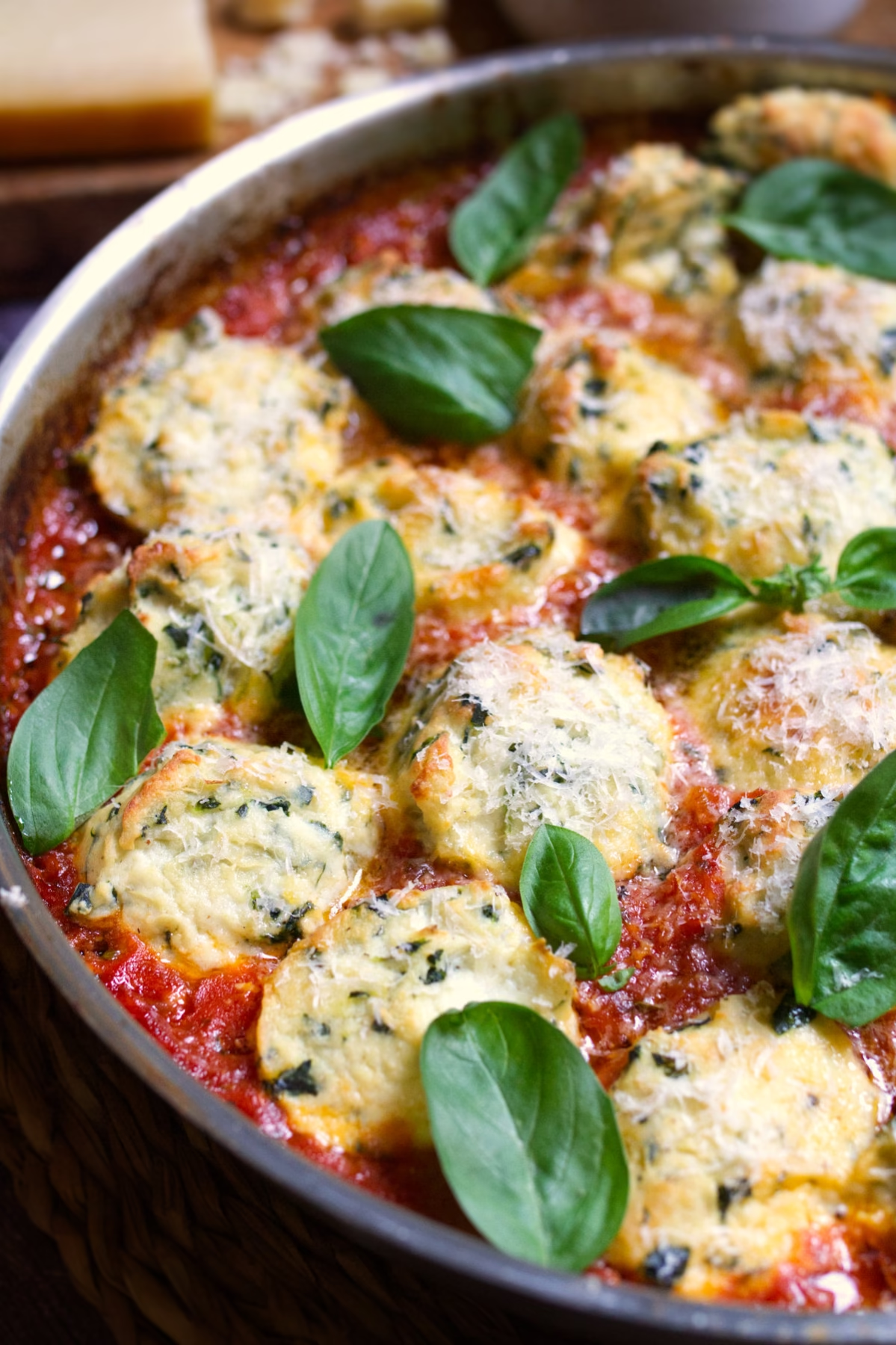
Sauces used with Malfatti Dumplings
You’ll find Malfatti served with acouple of different sauces, depending on where the recipe originates. We’ve also opted for a classic Napoli sauce for the baked version of this recipe, as it adds plenty of flavor and color to this dish.
Lombard Malfatti (Mantua/Brescia style)
- Tomato ragù (a slow-cooked meat sauce typical of Mantua), or
- Brown butter and crispy sage, plus a dusting of cheese.
Tuscan Malfatti (Gnudi — “Naked Ravioli”)
- Tomato ragù (a slow-cooked meat sauce typical of Mantua), or
- Brown butter and crispy sage, plus a dusting of cheese.
Napoli Sauce
A Napoli sauce (also called Sugo di Pomodoro alla Napoletana) is a cornerstone of Italian cooking: simple, bright, and full of pure tomato flavor. It’s the perfect pairing for Malfatti, gnocchi, or pasta. 🇮🇹🍅This sauce works particularly well when you are baking your Malfatti after boiling them.
Get our Printable Napoletana Sauce recipe here.
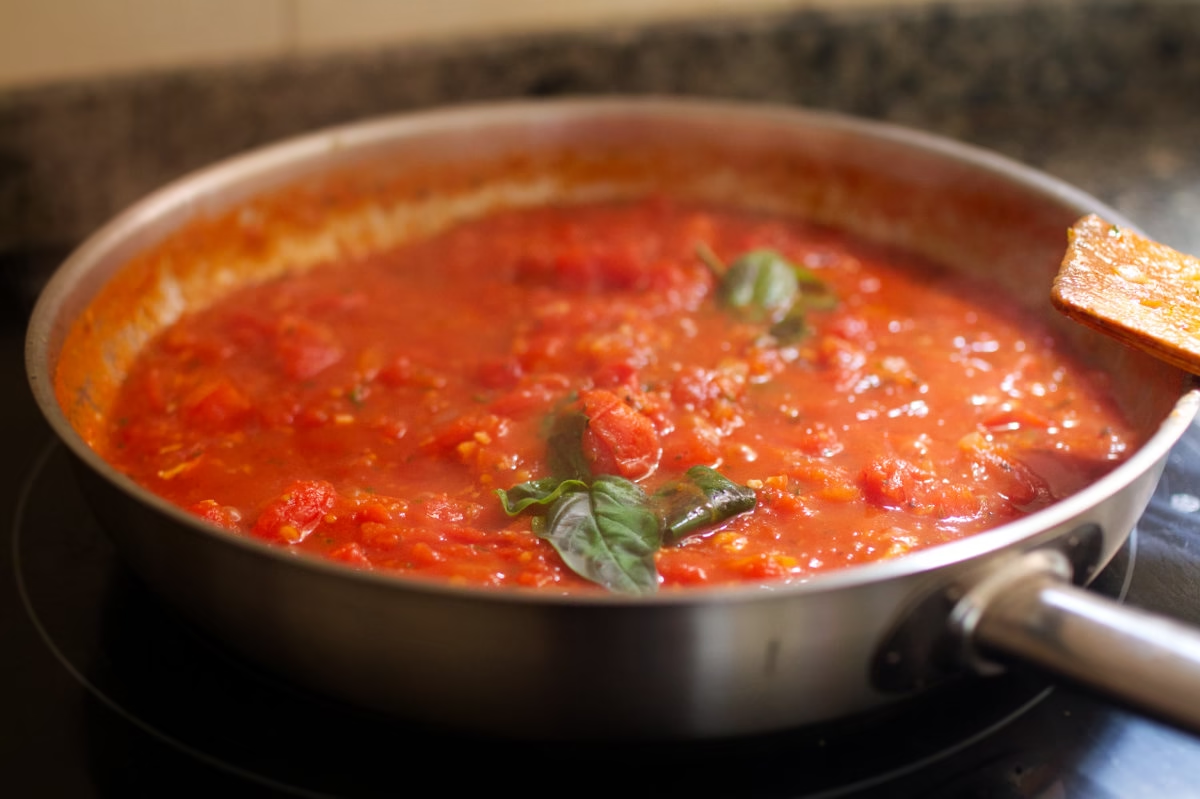
Wine pairings
Malfatti with Napoli sauce is a beautiful combination: soft, creamy dumplings with the fresh brightness of tomatoes and basil. The key to a good wine pairing is balancing the acidity of the sauce and the delicate texture of the dumplings.
Here are some thoughtful wine pairing suggestions, from traditional Italian options to a few international choices 👇
🇮🇹 Classic Italian Pairings
🍷 1. Chianti Classico (Tuscany)
- Profile: Medium-bodied, bright red fruit (cherry, plum), lively acidity, subtle herbal notes.
- Why it works: Chianti’s acidity complements the tomato sauce, while its earthy undertones echo the spinach and Parmesan in the Malfatti.
- Tip: Choose a younger Chianti (not Riserva) to keep the pairing fresh and light.
🍷 2. Montepulciano d’Abruzzo
- Profile: Juicy, soft tannins, ripe red and black fruit, slightly rustic.
- Why it works: It’s bold enough for the tomato sauce, but not overpowering — a friendly, everyday red that feels very “Italian family table.”
🍷 3. Barbera d’Alba or Barbera d’Asti (Piedmont)
- Profile: High acidity, low tannin, notes of cherry, raspberry, and spice.
- Why it works: The high acidity cuts through the richness of the ricotta and butter while harmonizing with the tomato’s tang.
- Bonus: It’s especially good if your sauce is on the garlicky or basil-heavy side.
🍷 4. Valpolicella Classico (Veneto)
- Profile: Light-bodied, red cherry and almond notes, elegant freshness.
- Why it works: A gentle red that won’t overwhelm the delicate Malfatti, but still bright enough for the tomato base.
🍷 5. Nero d’Avola (Sicily)
- Profile: Medium to full-bodied, dark fruit, hints of herbs and spice.
- Why it works: Adds warmth and depth — especially nice if your Napoli sauce has a touch of garlic, chili, or tomato paste richness.
🍾 White & Rosé Alternatives
🥂 1. Verdicchio dei Castelli di Jesi (Marche)
- Profile: Crisp, mineral, citrus and almond notes.
- Why it works: A refreshing counterpoint to the creamy ricotta filling; great if you prefer white wine.
🌸 2. Rosé from Provence or Bardolino Chiaretto
- Profile: Dry, fruity, and aromatic.
- Why it works: The lively acidity and subtle red fruit flavors marry well with tomato and basil, and the color looks beautiful with the dish.
🍋 3. Vermentino (Liguria / Sardinia)
- Profile: Zesty, floral, with a slight salinity.
- Why it works: Echoes the Mediterranean feel — especially if you add lemon zest or olive oil to your Malfatti dish.

Quick Pairing Summary
| Style | Wine | Why It Works |
| Classic red | Chianti Classico | Tomato acidity + rustic Tuscan match |
| Fruity red | Montepulciano d’Abruzzo | Soft, juicy, balanced |
| Bright red | Barbera d’Alba | High acidity for tomato & ricotta |
| Light red | Valpolicella Classico | Gentle and elegant |
| Fuller red | Nero d’Avola | Rich and warming |
| Crisp white | Verdicchio / Vermentino | Fresh contrast |
| Dry rosé | Provençal or Italian rosato | Balanced and summery |
Nutrition Facts — Baked Malfatti in Napoli Sauce
(Per serving — approximately 1/4 of total recipe)
| Nutrient | Amount per serving | % Daily Value (DV) |
| Calories | 420 kcal | — |
| Total Fat | 26 g | 33% |
| • Saturated Fat | 9 g | 45% |
| • Monounsaturated Fat | 13 g | — |
| • Polyunsaturated Fat | 2 g | — |
| Cholesterol | 115 mg | 38% |
| Sodium | 620 mg | 27% |
| Total Carbohydrates | 20 g | 7% |
| • Dietary Fiber | 3 g | 10% |
| • Total Sugars | 7 g | — |
| Protein | 27 g | 54% |
| Calcium | 380 mg | 30% |
| Iron | 2.4 mg | 13% |
| Potassium | 780 mg | 17% |
| Vitamin A | 5200 IU | 100% |
| Vitamin C | 22 mg | 25% |
Daily Values (DV%) are based on a 2,000-calorie diet. Individual requirements may vary.
⚖️ Nutritional Notes
- Ricotta & Parmesan: Major contributors of protein, calcium, and saturated fat.
- Spinach: Adds iron, vitamin A, and fiber.
- Tomatoes (Napoli sauce): Rich in vitamin C, potassium, and lycopene (an antioxidant).
- Olive oil: Provides healthy monounsaturated fats.
Overall balance: High in protein and calcium, moderate carbs, and heart-healthy fats — a nutritious, satisfying dish.
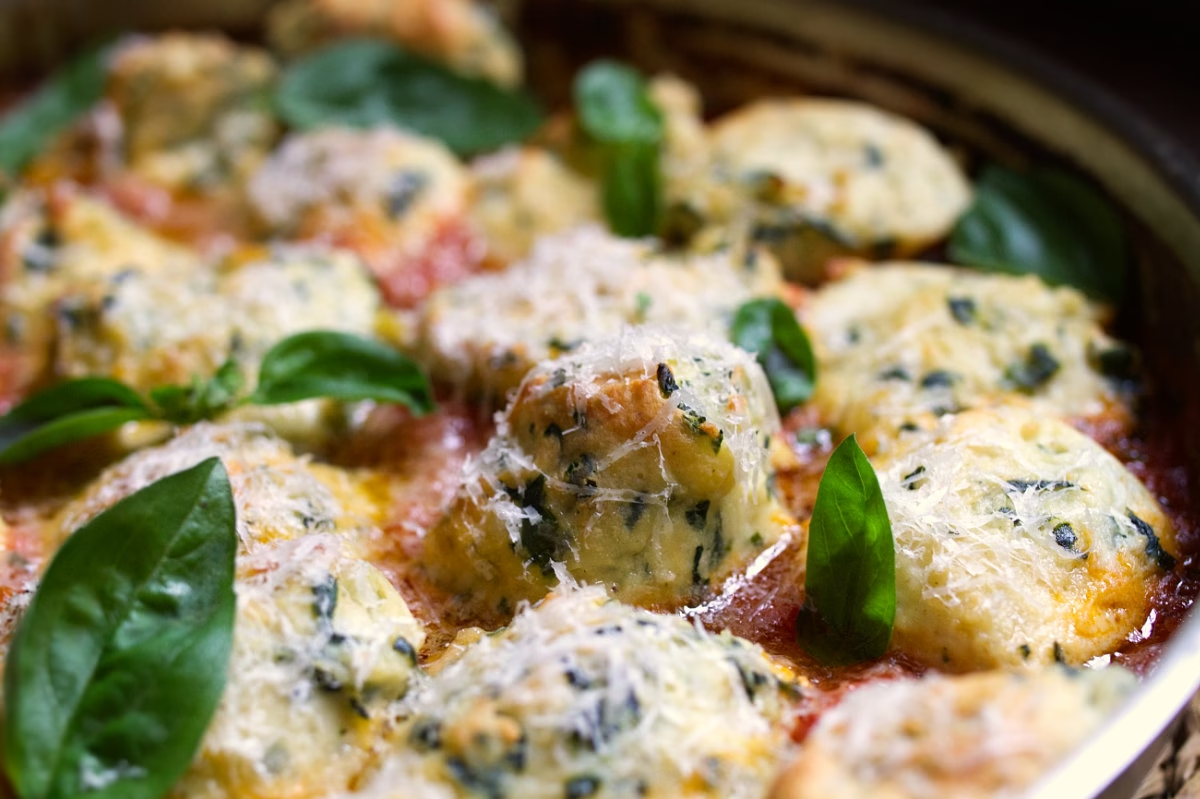
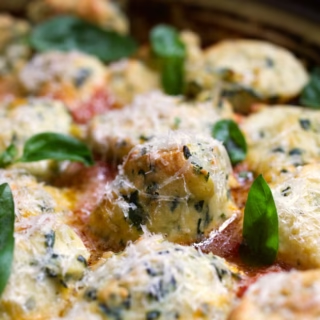
Malfatti – (Italian Spinach Ricotta Dumplings in Napoletana Sauce) 🇮🇹
Equipment
- 12-Inch Stainless Steel Frying Pan or skillet
- large glass bowl
- Mesh Strainers (flour sieve)
- Baking/Cooling rack
- Parchment paper
- Wooden Cutting Board
- Chef Knife
- Garlic press
- Immersion Blender (optional)
Ingredients
Napoli Sauce:
- Extra Virgin Olive Oil
- 1 small onion finely diced
- 3 garlic cloves minced
- 800 g 28 oz canned Tomatoes (ideally San Marzano)
- 2 Tbsp Tomato paste
- ½ tsp Dried Oregano organic
- A few fresh basil leaves with stems
- Salt and Freshly ground black pepper to taste
- 1 tsp white sugar
Malfatti:
- 5 oz. 150g spinach
- Salt
- 1 onion diced fine
- 3 garlic cloves minced
- 10.5 oz. 300g Ricotta Cheese
- 50 g ½ cup grated Parmigiano Reggiano DOP 18 months
- 2 Tbsp basil leaves finely diced
- 2 egg yolks discard the white
- Pinch of grated nutmeg
- 1/2 cup all-purpose flour add more or less to taste
- Salt and Pepper to taste
For Garnish and Serving:
- Parmesan finely grated
- Basil leaves
Instructions
Napoli Sauce:
Step 1 – Sauté aromatics
- In a wide pan, heat the olive oil over medium heat.Extra Virgin Olive Oil
- Add the onion and sauté for 5 minutes1 small onion
- Add the garlic and gently sauté until fragrant, around 2 minutes — do not let it burn.3 garlic cloves
Step 2 – Add tomatoes
- Add the canned tomatoes and stir through.800 g 28 oz canned Tomatoes (ideally San Marzano)
- If using whole (peeled) tomatoes, crush with a spoon or spatula.
Step 3 – Simmer
- Add a pinch of salt, some black pepper, oregano, and the tomato paste2 Tbsp Tomato paste, ½ tsp Dried Oregano, Salt and Freshly ground black pepper
- Reduce heat to low and let the sauce simmer gently for 20 minutes, stirring occasionally.
- The sauce should thicken slightly and the oil will rise to the top — a sign it’s ready.
- Taste and adjust seasoning (salt, pepper) and add any sugar if required.1 tsp white sugar
- Add the bunch of basil and simmer for another 10-15 minutes.A few fresh basil leaves
- Remove the basil before serving or blending.
Optional:
- For a smoother texture, pass the sauce through a food mill or blend briefly with an immersion blender.
Prepare the Malfatti:
- Add spinach leaves to a drying rack and season generously with salt, leave for 20 minutes to draw out excess liquid.5 oz. 150g spinach, Salt
- Use a kitchen towel to squeeze out excess liquid, then finely chop the spinach.
- Saute the onion for 5 minutes, then add the garlic and cook for another 1 minute, until fragrant.1 onion, 3 garlic cloves
- Add the chopped spinach and sauté for another 3-4 minutes to cook off some of the excess liquid.
- Remove sauteed spinach and onion from the pan and add to a large bowl to cool.
- Add the ricotta, grated Parmesan cheese, egg yolks, nutmeg, season with some salt and pepper to taste. Note: the spinach will already be quite salty.10.5 oz. 300g Ricotta Cheese, 50 g ½ cup grated Parmigiano Reggiano DOP 18 months, 2 Tbsp basil leaves, 2 egg yolks, Pinch of grated nutmeg, Salt and Pepper to taste
- Add flour a few tbsp at a time and mix. Add more flour if the dough is looking too wet.1/2 cup all-purpose flour
- Shape: Roll small dumplings (about walnut-sized) using floured hands. Place on a floured tray. Alternatiely, use two spoons to shape the balls.
- Refrigerate for 1 hour allow the balls to firm up and hold together better.
- Poach malfatti balls gently in simmering salted water until they float, then cook 1-2 minutes more.
- Remove balls from the water and set aside on some parchment paper to dry for 5 minutes.
Baking the Malfatti:
- Preheat oven to 180°C / 350°F.
- Pour Napoli Sauce into a baking dish (or use the same pan as we did), then top with the Malfatti.
- Drizzle with extra virgin olive oil and lightly season to taste with salt and pepper.
- Bake for 20 minutes.
Garnish and Serve:
- Garnish baked Malfatti with plenty of shaved parmesan cheese and a few fresh basil leaves.Parmesan, Basil leaves
Video
Notes
Cooking Notes:
Ricotta – Use the dry type that is usually found at the deli counter. A few good brands:- Casa del Formaggio
- Paesanella
FAQs — Malfatti (Italian Spinach Ricotta Dumplings)
1. What does “Malfatti” mean?
“Malfatti” literally means “badly made” in Italian — a playful reference to their rustic, uneven shapes. Despite the name, these dumplings are tender, flavorful, and comforting, often described as “naked ravioli” because they’re essentially ravioli filling without the pasta dough.
2. What’s the difference between Malfatti and Gnudi?
Both are spinach-and-ricotta dumplings, but Gnudi are traditionally Tuscan, often softer and served with butter and sage. Malfatti may come from Lombardy or Tuscany and are slightly firmer, sometimes baked or served with tomato-based sauces like Napoli sauce.
3. Why do my Malfatti fall apart when boiling?
The most common reason is excess moisture in the spinach or ricotta. Make sure both are very dry before mixing. Also, poach gently in simmering water, not a rolling boil — rough bubbles can break them apart. Adding a bit more flour or Parmesan can also help bind them.
4. Can I make Malfatti ahead of time?
Yes! Shape the dumplings and refrigerate them for up to 24 hours before cooking. You can also freeze them uncooked on a tray, then store them in a container. When ready, cook straight from frozen — just add an extra minute or two to the simmer time.
5. Can I use frozen spinach?
Absolutely. Thaw it completely, then squeeze out as much water as possible. Use a kitchen towel or press between plates to remove moisture — dry spinach ensures your dumplings stay firm.
6. What kind of ricotta should I use?
Use a dry, firm ricotta — typically found at the deli or Italian grocer. Wet ricotta (from tubs) should be drained for at least 30–60 minutes in a sieve or cheesecloth before mixing.
7. Can I skip baking and just serve the poached dumplings?
Yes, you can serve poached Malfatti directly with your favorite sauce — like brown butter and sage, or fresh tomato. Baking, however, gives them a lightly crisped top and a deeper flavor, especially when topped with Napoli sauce and Parmesan.
8. What can I serve with Malfatti?
Malfatti pair beautifully with a simple green salad, crusty Italian bread, or roasted vegetables. For drinks, try a Chianti Classico, Barbera d’Alba, or Verdicchio for a refreshing contrast.
9. How long do leftovers last?
Leftover baked Malfatti keep well for up to 3 days in the refrigerator. Reheat in the oven at 180°C (350°F) for 10–15 minutes, or gently microwave until warmed through.
10. Are Malfatti healthy?
Yes, relatively! They’re high in protein and calcium from ricotta and Parmesan, rich in vitamin A from spinach, and full of healthy fats from olive oil. It’s a wholesome, balanced dish that fits well into a Mediterranean-style diet.

